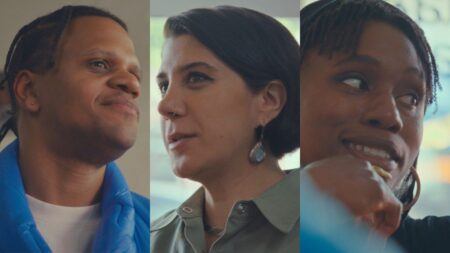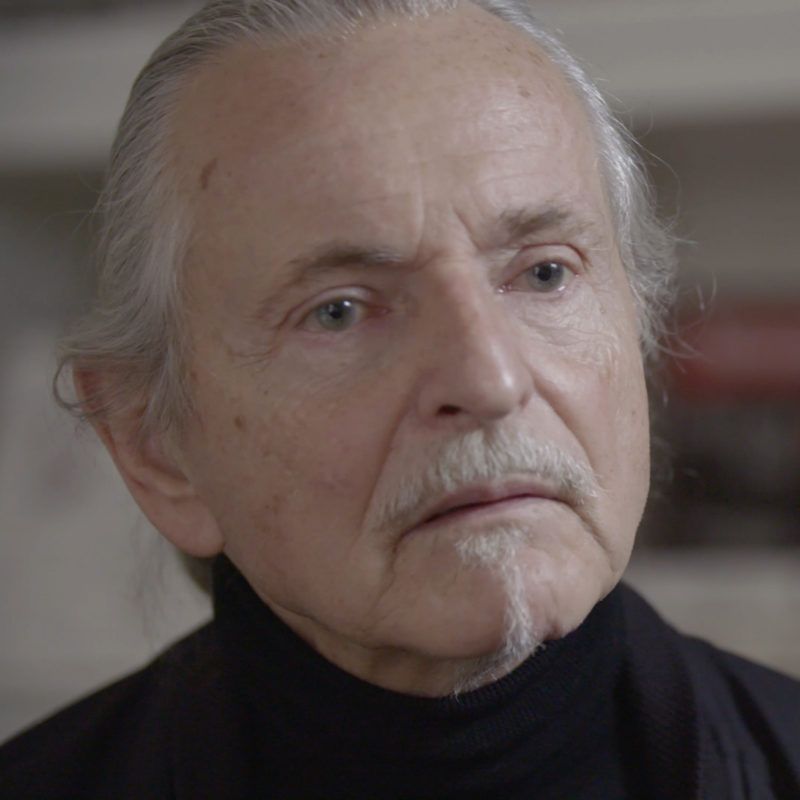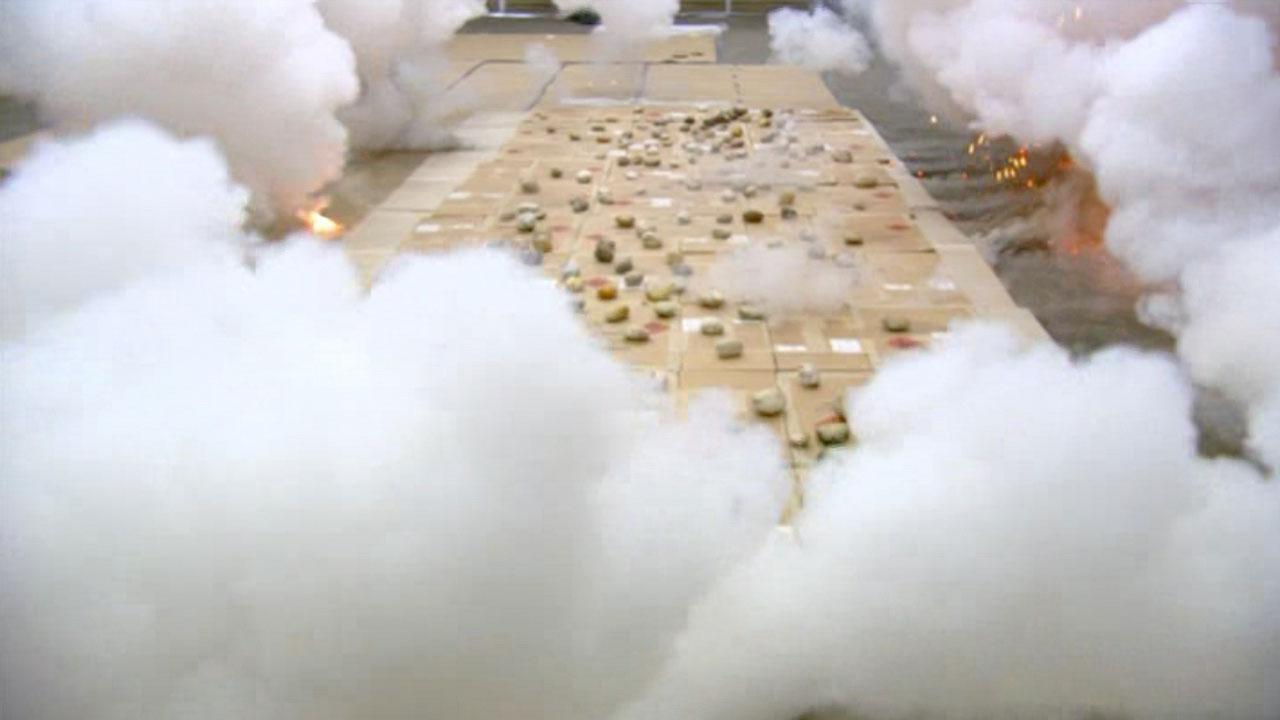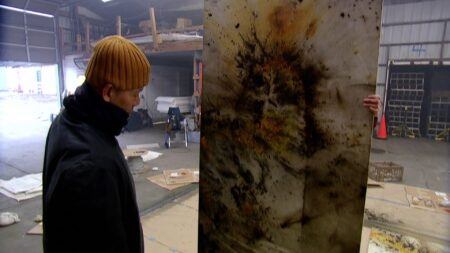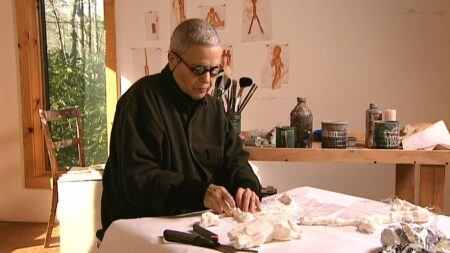Continue playing
(Time remaining: )
Play from beginning
Continue playing "{{ controller.videos[controller.getVideo(controller.currentVideo)].segmentParentTitle}}"
{{controller.videos[controller.getVideo(controller.currentVideo)].title}} has ended.
Krzysztof Wodiczko in "Power"
Through grand scale audio-video projects in public spaces, Krzysztof Wodiczko transforms national monuments and architectural façades into “bodies” as he collaborates with communities to get people to “break the code of silence, to open up and speak about what’s unspeakable.” Born of a Jewish mother who escaped the ghetto in World War II Poland, Wodiczko has been deeply affected by the devastation of war and violence all his life. In Hiroshima, he works with tearful survivors of the atomic bomb, helping them “to open up and share with the world what is so painful” through a commemorative projection. In Tijuana, he projects the faces of women onto the spherical façade of the city’s cultural center as they tell detailed stories of being abused.
Credits
Created by: Susan Sollins & Susan Dowling. Executive Producer & Curator: Susan Sollins. Series Producer: Eve-Laure Moros Ortega. Associate Producer: Migs Wright. Assistant Curator: Wesley Miller. Production Manager: Alice Bertoni. Production Coordinator: Kelly Shindler. Producer: Catherine Tatge. Editor: Steven Wechsler. Host: David Alan Grier. Director of Photography: Takahisa Araki, Richard Chisolm, Mark Falstad, Gary Henoch, Samuel Henriques, Mead Hunt, Tom Hurwitz, Joel Shapiro, David Smith, Ken Willinger, & Sérgio Zeigler. Sound: Tom Bergin, Steve Bores, Dwayne Dell, Bob Freeman, Roger Phenix, Merce Williams, & Sérgio Zeigler. Assistant Camera: Chris DeGuy, Craig Feldman, Brian Hwang, Steve Nealey, & Matt Thurber. Production Assistant: Matt Cavanaugh & Justin Leitstein. Assistant Avid Editor: Robert Achs, Jamie Courville, Sean Frechette, Mike Heffron, David Kreger, Cara Leroy O’Connell, Joaquin Perez, Aaron Sheddrick, & Lynn True. Voice-Over Artist (Cai Guo-Qiang segment): Clem Cheung. Translator (Cai Guo-Qiang segment): Ai Guo, Louisa Lam, & Mingxia Li. Still Photography: Alice Bertoni.
Creative Consultant: Ed Sherin. Art Design & Animation: Open, New York. On-Line Editor: Don Wyllie & Frame:Runner NYC. Composer: Peter Foley. Voice-Over Artist: Jace Alexander. Sound Editing: Margaret Crimmins, Greg Smith, & Dog Bark Sound. Sound Mix: Tony Volante & Sound Lounge. Animation Stand: Frank Ferrigno & Frame:Runner NYC. Introductory Host Segments Created by: INTERspectacular. Commissioned Video Art by: Teresa Hubbard / Alexander Birchler.
Artworks Courtesy of: Laylah Ali; Ida Applebroog; Cai Guo-Qiang; Krzysztof Wodiczko; 303 Gallery, New York; Galerie Lelong, New York; Miller Block Gallery, Boston; & Ronald Feldman Fine Arts, New York. Archival Footage Courtesy of; Artist Network Pictures/Takahisa Araki; Zlatko Cosic/EYE PRODUCTION; Fox News/KTVI; & Ufer! Art Documentary.
Special Thanks: Mariana Valdrighi Amaral; Katie Block; The Art21 Board of Trustees; Center for Advanced Visual Studies, MIT; Curious Pictures; Simon Greenberg; Fireworks by Grucci; Andrea Hall; Hirshhorn Museum and Sculpture Garden; Stephanie Joson; Tomoko Kimata; The Kitchen; Jennifer Wen Ma; Rita MacDonald; The Maritime Hotel; MASS MoCA; Dean Moss; Nicole Parente; Sarah Paulson; Soundtrack F/T; Mari Spirito; The Arthur M. Sackler and Freer Gallery of Art; Amm Talluto; Charwei Tsai; & Adam Whiton.
Director of Education & Outreach: Jessica Hamlin. Director of Development: Kathi Pavlick. Development Associate: Sara Simonson.
Interns: Susan Agliata, Nathan Townes-Anderson, Hannah Blumenthal, Agnes Bolt, Lisa Charde, Mary Chou, Kate Crawford, Amanda Donnan, Sophie Dunoyer de Segonzac, Suzy Foster, Jules Gaffney, Katie Hen, Heather Hughes, Adam Krakowski, Georgia Kung, David Mark Kupperberg, Maiko Kyogoku, Phil Logan, Lisa Margulies, Michelle Maydanchik, Carla Meyers, Christine Miller, Geoffrey Pan, Sujay Pandit, Jihan Robinson, Jennifer Sarkilahti, Megan Scally, Karen Seapker, Greg Shilling, Sarah Sliwa, Jennifer Smith, & Elizabeth Swift.
Public Relations: Kelly & Salerno Communications. Station Relations: De Shields Associates, Inc. Legal Counsel: Albert Gottesman. Bookkeeper: Marea Alverio-Chaveco & William Handy.
Major underwriting for Season 3 of Art in the Twenty-First Century is provided by National Endowment for the Arts, PBS, Agnes Gund and Daniel Shapiro, Nathan Cummings Foundation, Corporation for Public Broadcasting, Jon and Mary Shirley Foundation, Bagley Wright Fund Bloomberg, The Horace W. Goldsmith Foundation, JPMorgan Chase, Melva Bucksbaum and Raymond Learsy, The Paul G. Allen Family Foundation, and The Andy Warhol Foundation for the Visual Arts.
Closed captionsAvailable in English, German, Romanian, Italian, Japanese, Korean, Chinese, Italian
Through the Art21 Translation Project, multilingual audiences from around the globe can contribute translations, making Art21 films more accessible worldwide. Translate this video now.
Interested in showing this film in an exhibition or public screening? To license this video please visit Licensing & Reproduction.
By appropriating public buildings and monuments as backdrops for projections, Krzysztof Wodiczko focuses attention on ways in which architecture and monuments reflect collective memory and history. Projecting images of community members’ hands, faces, or entire bodies onto architectural façades, and combining those images with voiced testimonies, Wodiczko disrupts our traditional understanding of the functions of public space and architecture. He challenges the silent, stark monumentality of buildings, activating them in an examination of notions of human rights, democracy, and truths about the violence, alienation, and inhumanity that underlie countless aspects of social interaction in present-day society.
More from "Power"
Featuring David Alan Grier
